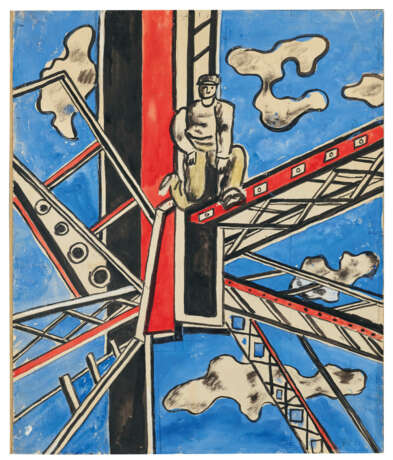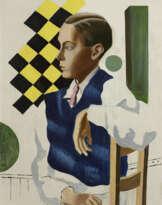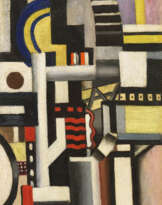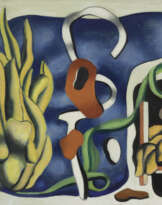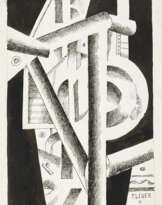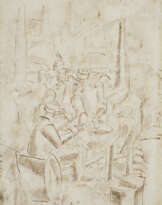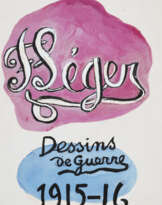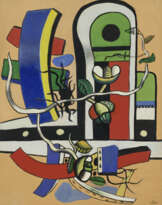ID 1053057
Лот 330 | Fernand Léger (1881-1955)
Оценочная стоимость
€ 380 000 – 550 000
Étude pour "Les Constructeurs"
signé des initiales et daté ‘F.L. 51’ (en bas à droite)
gouache, encre de Chine et trace de graphite sur papier
61.2 x 50.8 cm.
Exécuté en 1951
signed with the initiales and dated 'F.L. 51' (lower right)
gouache, brush and India ink and traces of pencil on paper
24 1⁄8 x 20 in.
Executed in 1951
Provenance
Galerie Louise Leiris, Paris.
Andre Lefevre, Paris (avant 1964).
Richard Feigen Gallery, Chicago.
Collection particuliere, France (en 1964).
Puis par descendance au proprietaire actuel.
Exhibited
Paris, Musée national d'Art Moderne, Collection André Lefèvre, mars-avril 1964, p. 30, no. 175.
Further details
Léger est au volant de sa voiture en région parisienne, dans la vallée de Chevreuse, lorsque lui vient l'idée de peindre Les Constructeurs (Musée Fernand Léger, Biot). « Il y avait là dans les champs, se souvient-il, une usine en construction. Je voyais les hommes se balancer en haut dans les poutres de fer ! Je voyais l'homme comme une puce, il semblait encore perdu dans ses inventions avec le ciel par-dessus. J'ai voulu rendre cela : le contraste entre l'homme et ses inventions, entre l'ouvrier et toute cette architecture métallique, ce fer, ces ferrailles, ces boulons, ces rivets. Les nuages, je les ai placés techniquement, mais ils jouent par contraste avec les poutres. Aucune concession sentimentale, même si mes figures sont plus variées, plus individualisées » (F. Léger in W. Schmalenbach, Léger, New York, 1976, p. 158). Inspiré par cette vision, Léger réalise dès 1947 quelques dessins préliminaires de ce qui deviendra, à terme, une ode magistrale à la condition ouvrière de France et d'ailleurs, dans un monde de plus en plus industrialisé.
La carrière de Léger est marquée dans son ensemble par la volonté de représenter et de toucher le peuple, groupe social dont se détache, à ses yeux, l'artiste moderne. Intégrer l'art à la vie contemporaine, égayer le quotidien du public en l'entourant d'images polychromes, telle est « la question centrale » de son art, « à laquelle il faut tenter d'apporter une solution » (F. Léger in ibid.). C'est sur le front de la Grande Guerre que l'artiste « [découvre] le peuple français » (F. Léger in R. Chickering, ed., Great War, Total War, Cambridge, 2000, p. 509). Les trois années passées auprès de ses frères d'armes bouleversent profondément sa démarche plastique : la réalité populaire et l'expérience partagée de la vie moderne, qu'il cherche à saisir dans toute leur immédiateté, deviennent ainsi les sujets privilégiés de ses œuvres d'entre-deux-guerres. Trente ans plus tard, ces préoccupations sont toujours bien présentes dans Les Constructeurs, tableau monumental dans lequel Léger veut montrer le travail acharné sur lequel repose la société. L'univers purement masculin qui en ressort tranche nettement avec Les Loisirs, scène enjouée de 1948-1949 où se mêlent hommes et femmes dans un ballet de formes organiques. Ici, au contraire, l'absence de féminité est rendue plus palpable encore par la prépondérance de formes géométriques et de lignes incisives.
Léger exécute cette Étude pour "Les Constructeurs" en 1951, peu de temps après la finalisation de son chef-d'œuvre du même nom. Plus qu'une simple étude, cette gouache s'inscrit à bien des égards dans la continuité de son grand hommage à la classe ouvrière. Perché sur un genou, à l'intersection de plusieurs poutres disposées en étoile, ici, un ouvrier semble vaciller. Autour de lui, la charpente toute enchevêtrée semble elle aussi défier les lois de la gravité. Le ciel est d'un bleu azur, parsemé de nuages duveteux. Comme à son habitude, Léger réduit sa palette à quelques couleurs vives et pures. Une fois achevé, Les Constructeurs, dans sa version la plus célèbre, est d'abord accroché dans la cantine des usines Renault dans l'espoir de susciter l'intérêt des ouvriers, susceptibles d'y être sensibles et de s'y identifier. Si l'œuvre ne rencontre pas immédiatement le succès escompté, elle finit timidement par gagner en popularité. Au bout de huit jours, Léger s'entretient avec l'un des travailleurs. « Et quand j’étais pour partir, raconte-t-il, un gars me dit : "Vous allez voir, ils vont s’apercevoir, mes copains, quand on aura enlevé les toiles, quand ils auront le mur tout nu devant, ils vont s’apercevoir ce que c’est que vos couleurs". [...] Ça fait plaisir, ça ! » (F. Léger in op. cit., 1976, p. 158).
Fernand Léger developed his idea for Les Constructeurs (Musée Fernand Léger, Biot) while driving to Chevreuse, outside Paris. As he recounted, ‘A factory was under construction in the fields there. I saw the men swaying high up on the steel girders! I saw man like a flea; he seemed still lost in his inventions with the sky above him. I wanted to render that; the contrast between man and his inventions, between the worker and all the metal architecture, that hardness, that ironwork, those bolts and rivets. The clouds, too, I arranged technically, but they form a contrast with the girders. No concession to sentimentality, even if my figures are more varied and individual’ (F. Léger quoted in W. Schmalenbach, Léger, New York, 1976, p. 158). Thus inspired, Léger began several preliminary drawings in 1947 for what was to become Les Constructeurs, his tribute to the working class both within France and for the increasingly industrial world at large.
Indeed, the artist was, throughout his life, concerned with how to reach and represent the people, a demographic he saw as separate to that of the modern artist. Léger understood that to be the ‘central point…which we must all try to solve’ – and one with which had had long himself been occupied (F. Léger quoted in ibid.). Indeed, it was while serving in the First World War that the artist ‘discovered the people of France’, his brothers in arms, an experience that profoundly impacted his art both in appearance and purpose, and Léger’s post-war paintings strove to capture the immediacy of their shared world (F. Léger quoted in R. Chickering, ed., Great War, Total War, Cambridge, 2000, p. 509). Such tendencies continue in Les Constructeurs, in which the artist endeavoured to reveal the labour upon which society rests. Interestingly, this is a wholly masculine world and, in stark contrast to his earlier Les Loisirs, devoid of female figures, a sense underscored by the geometrical forms and crisp outlines that fill the present work.
Léger created Étude pour "Les Constructeurs", 1951, following the completion of his celebrated painting, Les Constructeurs. More than simply a study, the present work is instead a continuation of sorts. The gouache shows a lone workman perched at the intersection of several beams that radiate outwards stellate-like. He balances precariously on one knee and the beams themselves overlap in ways that seemingly defy gravity. The sky is a bright, glassy blue, dotted with several soft clouds. Characteristically, Léger has limited his colour palette, here using just a few bright, bold colours. When finished, the related painting, Les Constructeurs, was first displayed in the canteen of the Renault automobile factory so that its workers could observe and engage with a work ostensibly related to their own lives. It was not an immediate success though the attitudes towards the painting did shift. After a week, Léger had an exchange with one man: ‘As I was leaving, one of them said to me: ‘You’re the painter, aren’t you? You’ll see, when your pictures are taken away and they are faced with a blank wall, my buddies will realize what’s in your colours’, Léger recalled. ‘That sort of thing is gratifying' (F. Léger quoted in op. cit., 1976, p. 158).
| Автор: | Фернан Леже (1881 - 1955) |
|---|---|
| Техника исполнения: | Гуашь |
| Автор: | Фернан Леже (1881 - 1955) |
|---|---|
| Техника исполнения: | Гуашь |
| Адрес торгов |
CHRISTIE'S 9 Avenue Matignon 75008 Paris Франция | ||||||||||||||
|---|---|---|---|---|---|---|---|---|---|---|---|---|---|---|---|
| Предосмотр |
| ||||||||||||||
| Телефон | +33 (0)1 40 76 85 85 | ||||||||||||||
| Факс | +33 (0)1 40 76 85 86 | ||||||||||||||
| Условия использования | Условия использования | ||||||||||||||
| Транспортировка |
Почтовая служба Курьерская служба Самовывоз | ||||||||||||||
| Способы оплаты |
Банковский перевод | ||||||||||||||
| Часы работы | Часы работы
|

